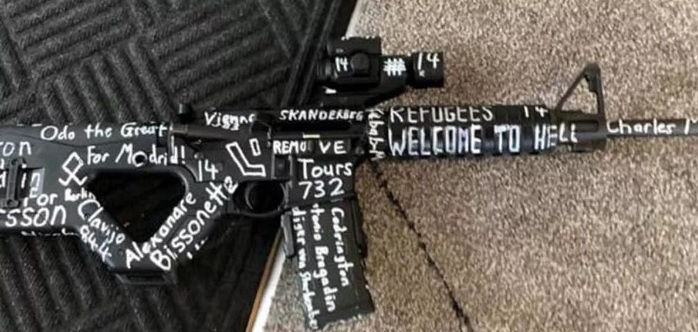List of names written on New Zealand terror accused Brenton Tarrant's guns
URL:
In one of the guns used by Brenton Tarrant, he had written names of several people using a white-ink marker.
The entire world was pulled to a state of shock when a man named Brenton Tarrant attacked two mosques in New Zealand and killed 49 people. The attacker streamed the video live on his Facebook page, and it was watched by thousands of viewers before the social media platform took it down. Soon after the massacre, Christchurch Police arrested the culprit, and they made it clear that he was driven by extreme right-wing ideologies.
In the video live streamed by Brenton Tarrant, we can clearly see some names written on his automatic gun using a white-ink marker. Upon closer analysis, investigators revealed that these were actually names of people who were involved in the killings of migrants.
International Business Times, India details about the names of the people written on the guns by Brenton Tarrant before the dreaded attack.

Anton Lundin Petterson
Anton Lundin Petterson is a 21-year-old man who carried out the Trollhättan school attack on October 22, 2015. During the attack, Petterson killed a teaching assistant and a male student, and later stabbed another male student and a teacher. Petterson later died of gunshot wounds he received during his apprehension.
Initial investigation conducted by Swedish Police revealed that Petterson was a hardcore racist, and he had selected the Kronan school because of its location in a neighbourhood with a high immigrant population.
Alexandre Bissonnette
Alexandre Bissonnette is the perpetrator of Quebec City Mosque shooting which happened on January 29, 2017. During the lone attack, Bissonnette killed six worshippers and 19 others were injured.
Upon investigations and court hearings, Bissonnette was sentenced to life imprisonment on February 08, 2019, with no possibility of parole for the next 40 years.
Skanderbeg
George Castriot, popularly known as Skanderbeg was initially an Ottoman military commander who lived in the 15th century.
Later, he led a rebellion against the Ottoman empire, and in 1443, he deserted the Ottomans during the Battle of Niš and became the ruler of Krujë, Svetigrad, and Modrič provinces.

Antonio Bragadin
Marco Antonio Bragadin was a military officer who lived in Venice in the 16th century. As the Captain-General of Famagusta in Cyprus, Bragadin led war against the Ottoman conquest in 1570.
Charles Martel
Charles Martel was a Frankish statesman and military leader who defeated the Spanish Muslims at the battle of Tours (732–33). Later, he began the military campaigns that reestablished the Franks as the rulers of Gaul.
It should be noted that New Zealand shooter Brenton Tarrant has named his manifesto 'The Great Replacement', and in many portions, he has talked against the Muslim immigration which is happening in Europe and other parts of the world.
URL:
In one of the guns used by Brenton Tarrant, he had written names of several people using a white-ink marker.
The entire world was pulled to a state of shock when a man named Brenton Tarrant attacked two mosques in New Zealand and killed 49 people. The attacker streamed the video live on his Facebook page, and it was watched by thousands of viewers before the social media platform took it down. Soon after the massacre, Christchurch Police arrested the culprit, and they made it clear that he was driven by extreme right-wing ideologies.
In the video live streamed by Brenton Tarrant, we can clearly see some names written on his automatic gun using a white-ink marker. Upon closer analysis, investigators revealed that these were actually names of people who were involved in the killings of migrants.
International Business Times, India details about the names of the people written on the guns by Brenton Tarrant before the dreaded attack.

Anton Lundin Petterson
Anton Lundin Petterson is a 21-year-old man who carried out the Trollhättan school attack on October 22, 2015. During the attack, Petterson killed a teaching assistant and a male student, and later stabbed another male student and a teacher. Petterson later died of gunshot wounds he received during his apprehension.
Initial investigation conducted by Swedish Police revealed that Petterson was a hardcore racist, and he had selected the Kronan school because of its location in a neighbourhood with a high immigrant population.
Alexandre Bissonnette
Alexandre Bissonnette is the perpetrator of Quebec City Mosque shooting which happened on January 29, 2017. During the lone attack, Bissonnette killed six worshippers and 19 others were injured.
Upon investigations and court hearings, Bissonnette was sentenced to life imprisonment on February 08, 2019, with no possibility of parole for the next 40 years.
Skanderbeg
George Castriot, popularly known as Skanderbeg was initially an Ottoman military commander who lived in the 15th century.
Later, he led a rebellion against the Ottoman empire, and in 1443, he deserted the Ottomans during the Battle of Niš and became the ruler of Krujë, Svetigrad, and Modrič provinces.

Antonio Bragadin
Marco Antonio Bragadin was a military officer who lived in Venice in the 16th century. As the Captain-General of Famagusta in Cyprus, Bragadin led war against the Ottoman conquest in 1570.
Charles Martel
Charles Martel was a Frankish statesman and military leader who defeated the Spanish Muslims at the battle of Tours (732–33). Later, he began the military campaigns that reestablished the Franks as the rulers of Gaul.
It should be noted that New Zealand shooter Brenton Tarrant has named his manifesto 'The Great Replacement', and in many portions, he has talked against the Muslim immigration which is happening in Europe and other parts of the world.






Comment